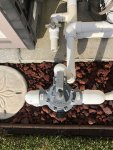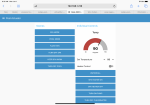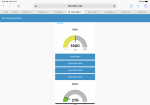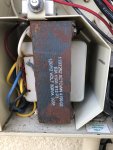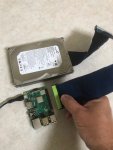After years of running out to the side of the house in my underwear to turn off my spa heater/pump (sorry for the visual), I have decided it is time to automate.
Thanks to this forum and several of the great threads, here we go!
(Disclaimer: While it is a *BUILD* thread, some may view it as a *RIP-OFF* thread )...
)...
Pool: 13,000 gallons, with spillover spa. Standard Marcite, with Acrylic deck (I believe CoolDeck). Main pool has color-changing light on the end (NOT LED). There is a light switch in the house the turns it on/off, and allows color selection.
The SPA light is standard, with a plastic red lens cover. If I redo the pool, I will replace with some form of color changing light. (Both lights turn on with single switch)
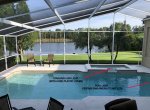
Pool Pad:
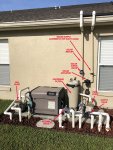
Current Equipment:
1) .75HP single speed pool pump
2) 1.5 HP single speed spa pump
3) Hayward heater (H400FDP) - We only use for the spa. This has constant power going to it (sits in STANDBY mode).
4) I have 8x12' solar panels on roof. Pretty much a hassle, but nice when they are not leaking.
5) Supply plumbed to pull from pool main drain or spa main drain (orange handles); Or plugged port in side of pool (haven't used in 18 years), or skimmer basket (selected from black Jandy 3-way valve).
6) Return plumbed to return to pool AND spa (normal operation), or just pool, or just spa (Grey 3-way valve)
7) Salt system - Owned by pool company that does chemicals every 2 weeks.
Controls:
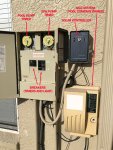
I have 30 Amp service running to the pool control area (double breaker in garage panel).
1) Intermatic Timer for Pool pump (runs every day of the year)
2) Intermatic Timer for Spa pump - I only use this timer to set the OFF time for about a half hour after I manually turn the heater off.
3) There is a transformer in the panel for the light, which I believe steps down to 12VAC.
4) Solar actuator controller - Monitors pool water temp from sensor drilled into pipe on supply side, and another sensor on the roof for air temperature.
5) Salt system controller. Never touch it.
Thanks to this forum and several of the great threads, here we go!
(Disclaimer: While it is a *BUILD* thread, some may view it as a *RIP-OFF* thread
Pool: 13,000 gallons, with spillover spa. Standard Marcite, with Acrylic deck (I believe CoolDeck). Main pool has color-changing light on the end (NOT LED). There is a light switch in the house the turns it on/off, and allows color selection.
The SPA light is standard, with a plastic red lens cover. If I redo the pool, I will replace with some form of color changing light. (Both lights turn on with single switch)

Pool Pad:

Current Equipment:
1) .75HP single speed pool pump
2) 1.5 HP single speed spa pump
3) Hayward heater (H400FDP) - We only use for the spa. This has constant power going to it (sits in STANDBY mode).
4) I have 8x12' solar panels on roof. Pretty much a hassle, but nice when they are not leaking.
5) Supply plumbed to pull from pool main drain or spa main drain (orange handles); Or plugged port in side of pool (haven't used in 18 years), or skimmer basket (selected from black Jandy 3-way valve).
6) Return plumbed to return to pool AND spa (normal operation), or just pool, or just spa (Grey 3-way valve)
7) Salt system - Owned by pool company that does chemicals every 2 weeks.
Controls:

I have 30 Amp service running to the pool control area (double breaker in garage panel).
1) Intermatic Timer for Pool pump (runs every day of the year)
2) Intermatic Timer for Spa pump - I only use this timer to set the OFF time for about a half hour after I manually turn the heater off.
3) There is a transformer in the panel for the light, which I believe steps down to 12VAC.
4) Solar actuator controller - Monitors pool water temp from sensor drilled into pipe on supply side, and another sensor on the roof for air temperature.
5) Salt system controller. Never touch it.
Last edited:


